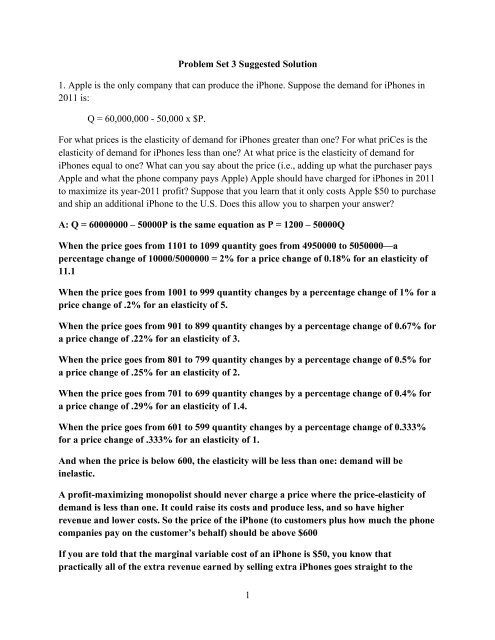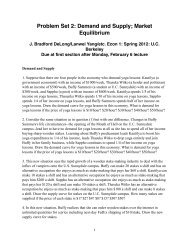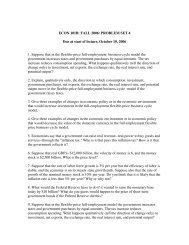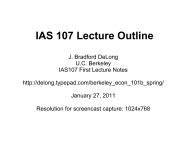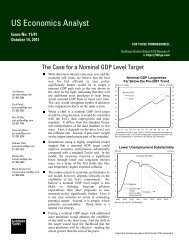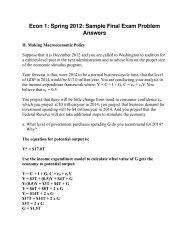Solutions to Problem Set 3 - Brad DeLong
Solutions to Problem Set 3 - Brad DeLong
Solutions to Problem Set 3 - Brad DeLong
Create successful ePaper yourself
Turn your PDF publications into a flip-book with our unique Google optimized e-Paper software.
<strong>Problem</strong> <strong>Set</strong> 3 Suggested Solution<br />
1. Apple is the only company that can produce the iPhone. Suppose the demand for iPhones in<br />
2011 is:<br />
Q = 60,000,000 - 50,000 x $P.<br />
For what prices is the elasticity of demand for iPhones greater than one For what priCes is the<br />
elasticity of demand for iPhones less than one At what price is the elasticity of demand for<br />
iPhones equal <strong>to</strong> one What can you say about the price (i.e., adding up what the purchaser pays<br />
Apple and what the phone company pays Apple) Apple should have charged for iPhones in 2011<br />
<strong>to</strong> maximize its year-2011 profit Suppose that you learn that it only costs Apple $50 <strong>to</strong> purchase<br />
and ship an additional iPhone <strong>to</strong> the U.S. Does this allow you <strong>to</strong> sharpen your answer<br />
A: Q = 60000000 – 50000P is the same equation as P = 1200 – 50000Q<br />
When the price goes from 1101 <strong>to</strong> 1099 quantity goes from 4950000 <strong>to</strong> 5050000—a<br />
percentage change of 10000/5000000 = 2% for a price change of 0.18% for an elasticity of<br />
11.1<br />
When the price goes from 1001 <strong>to</strong> 999 quantity changes by a percentage change of 1% for a<br />
price change of .2% for an elasticity of 5.<br />
When the price goes from 901 <strong>to</strong> 899 quantity changes by a percentage change of 0.67% for<br />
a price change of .22% for an elasticity of 3.<br />
When the price goes from 801 <strong>to</strong> 799 quantity changes by a percentage change of 0.5% for<br />
a price change of .25% for an elasticity of 2.<br />
When the price goes from 701 <strong>to</strong> 699 quantity changes by a percentage change of 0.4% for<br />
a price change of .29% for an elasticity of 1.4.<br />
When the price goes from 601 <strong>to</strong> 599 quantity changes by a percentage change of 0.333%<br />
for a price change of .333% for an elasticity of 1.<br />
And when the price is below 600, the elasticity will be less than one: demand will be<br />
inelastic.<br />
A profit-maximizing monopolist should never charge a price where the price-elasticity of<br />
demand is less than one. It could raise its costs and produce less, and so have higher<br />
revenue and lower costs. So the price of the iPhone (<strong>to</strong> cus<strong>to</strong>mers plus how much the phone<br />
companies pay on the cus<strong>to</strong>mer’s behalf) should be above $600<br />
If you are <strong>to</strong>ld that the marginal variable cost of an iPhone is $50, you know that<br />
practically all of the extra revenue earned by selling extra iPhones goes straight <strong>to</strong> the<br />
1
ot<strong>to</strong>m line, so that the profit-maximizing price will be close <strong>to</strong> the revenue-maximizing<br />
price. Therefore you can sharpen your answer and conclude that the profit-maximizing<br />
price for iPhones is close <strong>to</strong> $600.<br />
2. Consider the following two demand curves for yoga lessons in Sunnydale: Q = 120 - 3P; and PQ 2 =<br />
20000. Consider the market-day supply curve Q = 20. What is the price for each demand curve Suppose<br />
that on one day the market day supply curve is Q = 15. What is the price for each demand curve<br />
A: For the first demand curve and the first supply curve set the quantity from the demand curve<br />
equal <strong>to</strong> the quantity from the supply curve, 120 – 3P = 20; P = 33 1/3; Q = 20.<br />
For the second demand curve and the first supply curve substitute the supply curve expression for<br />
quantity in<strong>to</strong> the demand curve, P/400 = 20000; P = 50 Q = 20.<br />
For the first demand curve and the second supply curve set the quantity from the demand curve<br />
equal <strong>to</strong> the quantity from the supply curve, 120 – 3P = 15; P = 35; Q = 15.<br />
For the second demand curve and the second supply curve substitute the supply curve expression<br />
for quantity in<strong>to</strong> the demand curve, P/225 = 20000; P = 88.89 Q = 15.<br />
3. Consider the following two demand curves for yoga lessons in Sunnydale: Q = 120 - 3P; and PQ 2 =<br />
20000. Consider the short-run supply curve Q = 3 x P. What is the price for each demand curve What is<br />
the quantity Suppose that the short-run supply curve is Q = 3 x P + 10. What is the price for each<br />
demand curve What is the quantity<br />
A: For the first demand curve and the first supply curve set the quantity from the demand curve<br />
equal <strong>to</strong> the quantity from the supply curve, 120 – 3P = 3P; 6P = 120; solving P = 20; Q = 60.<br />
For the second demand curve and the first supply curve substitute the supply curve expression for<br />
quantity in<strong>to</strong> the demand curve, P(9P 2 ) = 20000; 9P 3 = 20000; taking the cube root: P = 13.04 Q =<br />
39.12.<br />
For the first demand curve and the second supply curve set the quantity from the demand curve<br />
equal <strong>to</strong> the quantity from the supply curve, 120 – 3P = 3P+10; solving P = 18.33; Q = 65.<br />
For the second demand curve and the second supply curve substitute the supply curve expression<br />
for quantity in<strong>to</strong> the demand curve, P(3P+10) 2 = 20000; 9P 3 + 60 P 2 + 100P = 20000; solving the<br />
cubic: 10.93 Q = 42.79.<br />
4. Consider the following two demand curves for yoga lessons in Sunnydale: Q = 120 - 3P; PQ = 750.<br />
Consider the very long run supply curve P = 20. What is the quantity for each demand curve Suppose<br />
that improvements in technology lead the very long run supply curve <strong>to</strong> shift down <strong>to</strong> P = 15. What is the<br />
quantity for each demand curve<br />
A: For the first demand curve, Q=60. For the second demand curve, Q=37.5. With the new ver<br />
long-run supply curve P=15, Q=45 for the first demand curve and Q=50 for the second.<br />
5. In your estimation, what are the four most important reasons Partha Dasgupta believes are<br />
responsible for the fact that Becky's life options are broader than Desta's<br />
2
A: A possible list:<br />
a) Household’s decision making is spread in Desta’s world, limiting the ability of one<br />
member <strong>to</strong> take an optimal decision based on his or her situation.<br />
b) Allocation of resources, here it is food, leisure, basic necessities, is distributed unequally<br />
in Desta’s world. This is a problem if those need them the most is given less than what is<br />
required <strong>to</strong> be productive.<br />
c) Gender inequality and fertility: high fertility in Desta’s world lead <strong>to</strong> high rate of<br />
illiteracy among women, less women in the workforce and low paid jobs for women.<br />
d) Property right and fertility: in Desta’s world, the opportunity cost of rearing a child is<br />
low, thus many children were born. In addition, in the sub-Saharan Africa, large family<br />
was given more land, and this serves as a reward for parents <strong>to</strong> have more children.<br />
e) Desta doesn’t have access <strong>to</strong> insurance, making themselves vulnerable <strong>to</strong> shocks.<br />
f) Desta doesn’t have access <strong>to</strong> capital market for borrowing/saving/investing opportunity.<br />
This also makes them vulnerable <strong>to</strong> shocks.<br />
g) Lack of institutions that facilitate market operations such as financial institution or<br />
limited liability joint s<strong>to</strong>ck companies where Becky can invest and pool risk.<br />
6. Professor <strong>DeLong</strong> has claimed that the experience of the twentieth century teaches us that<br />
what share of our prosperity rests on the foundations of the market economy Why has he said<br />
this Do you find his argument convincing Why or why not Limit your answer <strong>to</strong>, at most, 150<br />
words.<br />
A: Prof. Delong mentioned several times in his note that there is a five-fold difference in<br />
efficiency between a centrally-planned and a market economies. Why do we need <strong>to</strong> know<br />
this, and perhaps, study economics A market economy can deal well with the very<br />
problem facing the world: resource scarcity. Price signal guides the market <strong>to</strong>wards<br />
producing goods that are most desired by the society. Market economy allows<br />
specialization and trade and creates a win-win situation in which everyone is better off.<br />
Market economy eliminates the cost of coordination or cost of governing the market in a<br />
centrally planned economy. However, one may raise a counter argument about the fairness<br />
of income distribution, and the fairness of international trade and those suffer the most are<br />
always poor and less developed countries.<br />
7. Describe how a market system efficiently allocates scarce resources. Limit your answer <strong>to</strong>, at<br />
most, 100 words.<br />
3
There are two approaches. The first one is relatively straightforward from the material at<br />
the beginning of the class. Perhaps, the second method is more relevant.<br />
First, we may want <strong>to</strong> know how using the concept of opportunity cost and gain from trade<br />
can explain why everyone is better off than in autarky. By specializing in what each person<br />
has comparative advantage in and allow them <strong>to</strong> trade, we can consume at point outside of<br />
the PPF – points which were unattainable if people were not allowed <strong>to</strong> trade.<br />
Second, a market system does allow us <strong>to</strong> achieve both productive and allocative efficiency.<br />
A comprehensive answer may need <strong>to</strong> go a little bit further <strong>to</strong> explain these two concepts.<br />
Productive efficiency (PE): produce with the least cost method (in term of opportunity cost)<br />
and allocative efficiency (AE): produce what the society wants. While PE can be achieved<br />
by a centrally planned economy, only a laisser-faire market will allow us <strong>to</strong> achieve AE<br />
through price signal.<br />
8. Describe how market forces reach an equilibrium where the quantity demanded exactly equals<br />
the quantity supplied. Limit your answer <strong>to</strong>, at most, 100 words.<br />
P <br />
Excess Supply <br />
S <br />
P A <br />
E <br />
P B <br />
Excess Demand <br />
D <br />
A: A graph will make the answer a lot more intuitive. Suppose that for some reason, the<br />
market is not yet at equilibrium (point E, the intersection between Demand and Supply). If<br />
the current market price is at P A greater than the equilibrium price, quantity demanded is<br />
less than quantity supplied, resulting in excess supply (or demand shortage). Some sellers<br />
may not be able <strong>to</strong> sell their goods. To clear the market, the sellers have <strong>to</strong> reduce price. At<br />
the same time, as price falls, quantity demanded increases. We move along the supply and<br />
demand curve until equilibrium is reached.<br />
Q <br />
4
The opposite is when the initial price is less than the equilibrium price. Then quantity<br />
demanded is greater than quantity supply, or we have an excess demand (or supply<br />
shortage) situation. Some buyers may not be able <strong>to</strong> buy the goods at low price. Thus,<br />
buyers bid up the price <strong>to</strong> get a chance <strong>to</strong> get the goods. We move back <strong>to</strong> equilibrium at<br />
point E where quantity demanded is equal <strong>to</strong> quantity supplied.<br />
9. Why are producers able <strong>to</strong> pass on most of a tax on goods like cigarettes and gasoline on<strong>to</strong><br />
consumers Why would producers bear most of a tax on agricultural goods<br />
A: For most addictive goods like cigarettes, alcohol, and in the extreme case drugs, the<br />
demand is very inelastic. For goods with no alternative like gasoline, the demand is also<br />
inelastic, at least in the short term. Note that the word “inelastic” I used here means that<br />
the demand doesn’t change much as we increase the price, or the demand schedule of such<br />
goods is very steep. When we talk about the price elascitity of demand, “inelastic” means<br />
that the absolute value of the coefficient is less than 1. For such goods, the burden of the tax<br />
is born mostly by the consumers, as shown in the graph. A tax results in higher prices (thus<br />
tax revenue for the government), and in little change in the quantity demanded.<br />
P <br />
Demand for Cigarettes or Gasoline <br />
Consumer’s <br />
Burden of Tax <br />
P C <br />
A <br />
Tax <br />
P E <br />
P S <br />
B <br />
E <br />
Producer’s <br />
Burden of Tax <br />
* Note <strong>to</strong> Prof. <strong>Brad</strong> and fellow GSIs:<br />
Q E <br />
Q <br />
5
For agricultural goods, my take is that due <strong>to</strong> so many alternatives, any producer raising price<br />
risk losing business. Thus, we may expect a steep supply curve and perhaps, flatter demand<br />
curve. If it is the case, then most tax burden is passed <strong>to</strong> the producers.<br />
However, I am unimpressed <strong>to</strong> force this argument. Agricultural demand curve is also very steep,<br />
especially when we talk about the demand for foods and related products. Another complication<br />
is that agricultural goods producers are working on a small profit margin (real life issue),<br />
imposing tax on agricultural goods only passes <strong>to</strong> the consumers through a higher price (same<br />
thing when we talk about market structure, entry and exit in the LR and SR).<br />
4. With two new demand function Q=120-3P and PQ=750. Rewrite it as<br />
P=40−13Q and P=750Q<br />
For two supply curve P=20 and P=15, let supply=demand, then we have<br />
40−13Q=20 t en Q =60<br />
Similarly,<br />
40−13Q=15 t en Q =75<br />
And<br />
750Q=20 t en Q =37.5<br />
and<br />
750Q=15 t en Q =50<br />
5. In your estimation, what are the four most important reasons Partha Dasgupta believes are<br />
responsible for the fact that Becky's life options are broader than Desta's<br />
This list may not be enough:<br />
a) Household’s decision making is spread in Desta’s world, limiting the ability of one member <strong>to</strong><br />
take an optimal decision based on his or her situation.<br />
b) Allocation of resources, here it is food, leisure, basic necessities, is distributed unequally in<br />
Desta’s world. This is a problem if those need them the most is given less than what is required<br />
<strong>to</strong> be productive.<br />
c) Gender inequality and fertility: high fertility in Desta’s world lead <strong>to</strong> high rate of illiteracy<br />
among women, less women in the workforce and low paid jobs for women.<br />
d) Property right and fertility: in Desta’s world, the opportunity cost of rearing a child is low,<br />
thus many children were born. In addition, in the sub-Saharan Africa, large family was given<br />
more land, and this serves as a reward for parents <strong>to</strong> have more children.<br />
e) Desta doesn’t have access <strong>to</strong> insurance, making themselves vulnerable <strong>to</strong> shocks.<br />
f) Desta doesn’t have access <strong>to</strong> capital market for borrowing/saving/investing opportunity. This<br />
also makes them vulnerable <strong>to</strong> shocks.<br />
6
g) Lack of institutions that facilitate market operations such as financial institution or limited<br />
liability joint s<strong>to</strong>ck companies where Becky can invest and pool risk.<br />
6. Professor <strong>DeLong</strong> has claimed that the experience of the twentieth century teaches us that<br />
what share of our prosperity rests on the foundations of the market economy Why has he said<br />
this Do you find his argument convincing Why or why not Limit your answer <strong>to</strong>, at most, 150<br />
words.<br />
(Just what I think)<br />
Prof. Delong mentioned several times in his note that there is a five-fold difference in efficiency<br />
between a centrally-planned and a market economies. Why do we need <strong>to</strong> know this, and<br />
perhaps, study economics A market economy can deal well with the very problem facing the<br />
world: resource scarcity. Price signal guides the market <strong>to</strong>wards producing goods that are most<br />
desired by the society. Market economy allows specialization and trade and creates a win-win<br />
situation in which everyone is better off. Market economy eliminates the cost of coordination or<br />
cost of governing the market in a centrally planned economy. However, one may raise a counter<br />
argument about the fairness of income distribution, and the fairness of international trade and<br />
those suffer the most are always poor and less developed countries.<br />
7. Describe how a market system efficiently allocates scarce resources. Limit your answer <strong>to</strong>, at<br />
most, 100 words.<br />
There are two approaches. The first one is relatively straightforward from the material at the<br />
beginning of the class. Perhaps, the second method is more relevant.<br />
First, we may want <strong>to</strong> know how using the concept of opportunity cost and gain from trade can<br />
explain why everyone is better off than in autarky. By specializing in what each person has<br />
comparative advantage in and allow them <strong>to</strong> trade, we can consume at point outside of the PPF –<br />
points which were unattainable if people were not allowed <strong>to</strong> trade.<br />
Second, a market system does allow us <strong>to</strong> achieve both productive and allocative efficiency. A<br />
comprehensive answer may need <strong>to</strong> go a little bit further <strong>to</strong> explain these two concepts.<br />
Productive efficiency (PE): produce with the least cost method (in term of opportunity cost) and<br />
allocative efficiency (AE): produce what the society wants. While PE can be achieved by a<br />
centrally planned economy, only a laisser-faire market will allow us <strong>to</strong> achieve AE through price<br />
signal.<br />
8. Describe how market forces reach an equilibrium where the quantity demanded exactly equals<br />
the quantity supplied. Limit your answer <strong>to</strong>, at most, 100 words.<br />
P <br />
P A <br />
Excess Supply S <br />
7 <br />
E <br />
P B
D <br />
A graph will make the answer a lot more intuitive. Suppose that for some reason, the market is<br />
not yet at equilibrium (point E, the intersection between Demand and Supply). If the current<br />
market price is at P A greater than the equilibrium price, quantity demanded is less than quantity<br />
supplied, resulting in excess supply (or demand shortage). Some sellers may not be able <strong>to</strong> sell<br />
their goods. To clear the market, the sellers have <strong>to</strong> reduce price. At the same time, as price falls,<br />
quantity demanded increases. We move along the supply and demand curve until equilibrium is<br />
reached.<br />
The opposite is when the initial price is less than the equilibrium price. Then quantity demanded<br />
is greater than quantity supply, or we have an excess demand (or supply shortage) situation.<br />
Some buyers may not be able <strong>to</strong> buy the goods at low price. Thus, buyers bid up the price <strong>to</strong> get<br />
a chance <strong>to</strong> get the goods. We move back <strong>to</strong> equilibrium at point E where quantity demanded is<br />
equal <strong>to</strong> quantity supplied.<br />
9. Why are producers able <strong>to</strong> pass on most of a tax on goods like cigarettes and gasoline on<strong>to</strong><br />
consumers Why would producers bear most of a tax on agricultural goods<br />
To explain this part better, students also need <strong>to</strong> draw good graphs.<br />
For most additive goods like cigarette, alcohols and <strong>to</strong> the extreme case, drug, the demand is<br />
very inelastic. For goods with no alternative like gasoline, the demand is also inelastic, at least in<br />
the short term. Note that the word “inelastic” I used here means that the demand doesn’t change<br />
much as we increase the price, or the demand schedule of such goods is very steep. When we<br />
talk about the price elascitity of demand coefficient, “inelastic” means that the absolute value of<br />
the coefficient is less than 1.<br />
For such goods, the burden of tax is born mostly by the consumers, as shown in the graph. Tax<br />
only results in higher price (thus tax revenue for the government), yet quantity demanded<br />
changes very little.<br />
P <br />
Demand for Cigarettes or Gasoline <br />
8 <br />
Consumer’s <br />
Burden of Tax <br />
P C <br />
A
* Note <strong>to</strong> Prof. <strong>Brad</strong> and fellow GSIs:<br />
For agricultural goods, my take is that due <strong>to</strong> so many alternatives, any producer raising price<br />
risk losing business. Thus, we may expect a steep supply curve and perhaps, flatter demand<br />
curve. If it is the case, then most tax burden is passed <strong>to</strong> the producers.<br />
However, I am unimpressed <strong>to</strong> force this argument. Agricultural demand curve is also very steep,<br />
especially when we talk about the demand for foods and related products. Another complication<br />
is that agricultural goods producers are working on a small profit margin (real life issue),<br />
imposing tax on agricultural goods only passes <strong>to</strong> the consumers through a higher price (same<br />
thing when we talk about market structure, entry and exit in the LR and SR).<br />
3.<br />
4.<br />
5. In your estimation, what are the four most important reasons Partha Dasgupta believes are responsible<br />
for the fact that Becky's life options are broader than Desta's<br />
6. In no fewer than four lectures so far, Professor <strong>DeLong</strong> has claimed that the experience of the twentieth<br />
century teaches us that what share of our prosperity rests on the foundations of the market economy Why<br />
has he said this Do you find his argument convincing Why or why not Limit your answer <strong>to</strong>, at most,<br />
150 words.<br />
7. Describe how a market system efficiently allocates scarce resources. Limit your answer <strong>to</strong>, at most, 100<br />
words.<br />
8. Describe how market forces reach an equilibrium where the quantity demanded exactly equals the<br />
quantity supplied. Limit your answer <strong>to</strong>, at most, 100 words.<br />
9
9. Why are producers able <strong>to</strong> pass on most of a tax on goods like cigarettes and gasoline on<strong>to</strong> consumers<br />
Why would producers bear most of a tax on agricultural goods<br />
10


